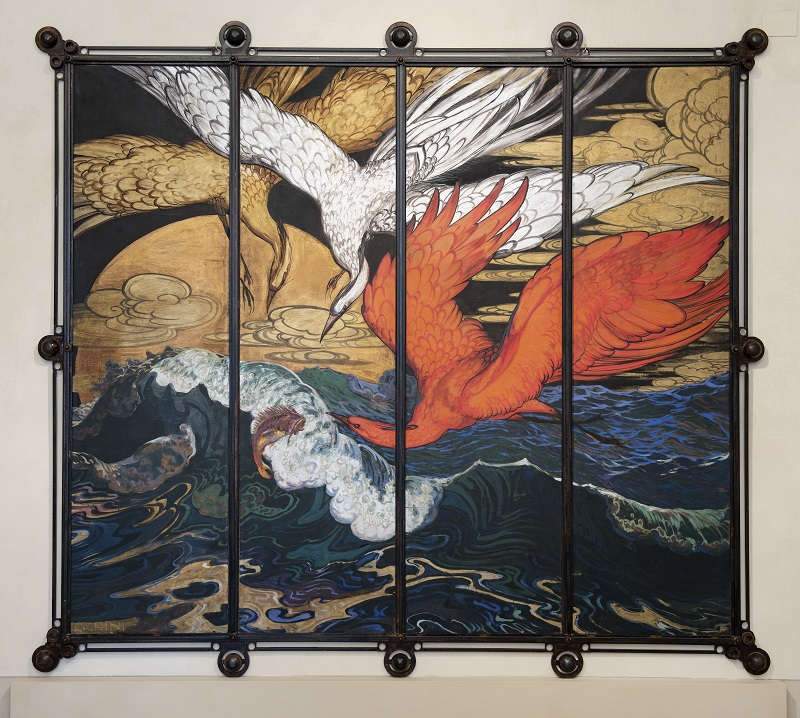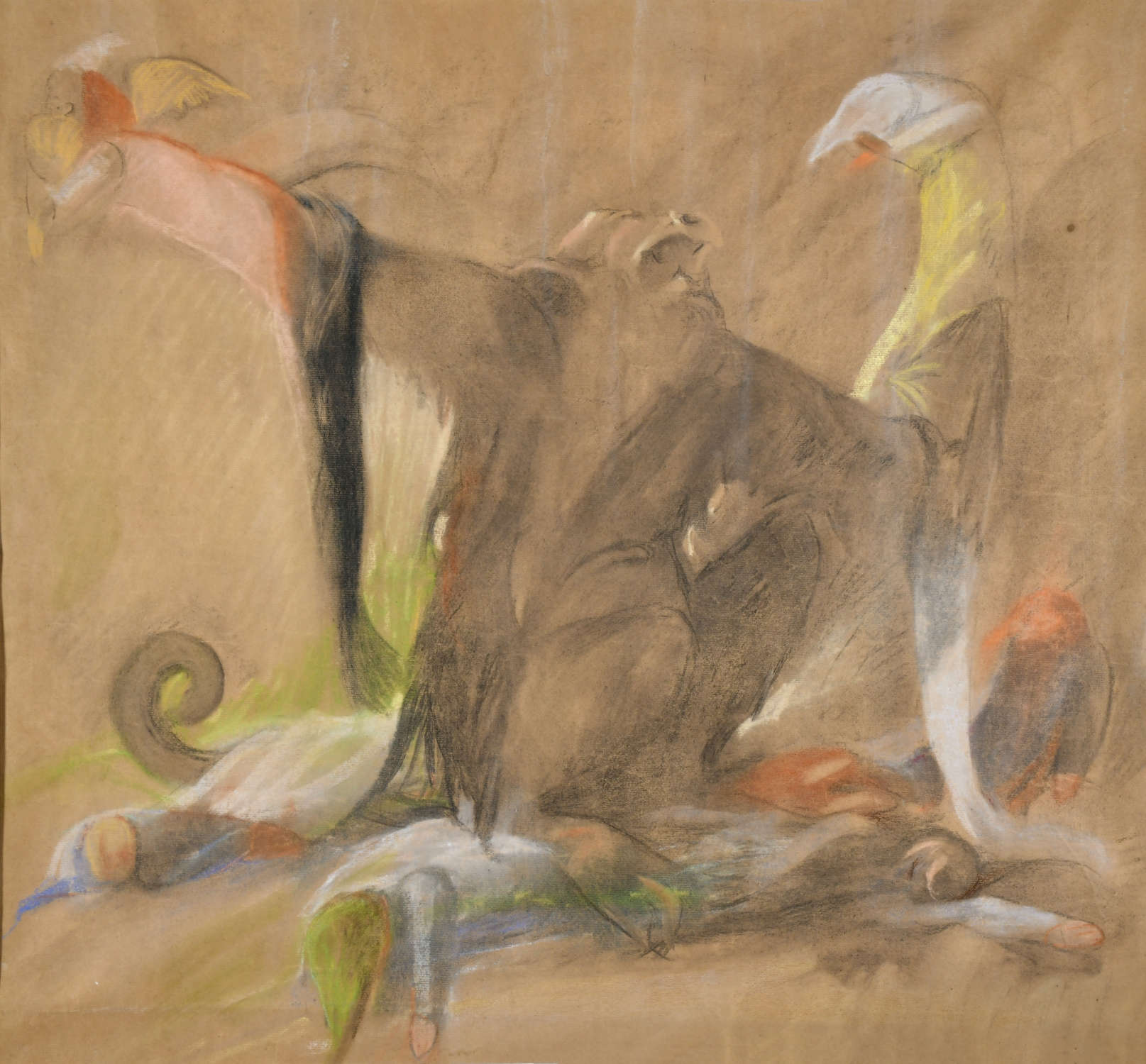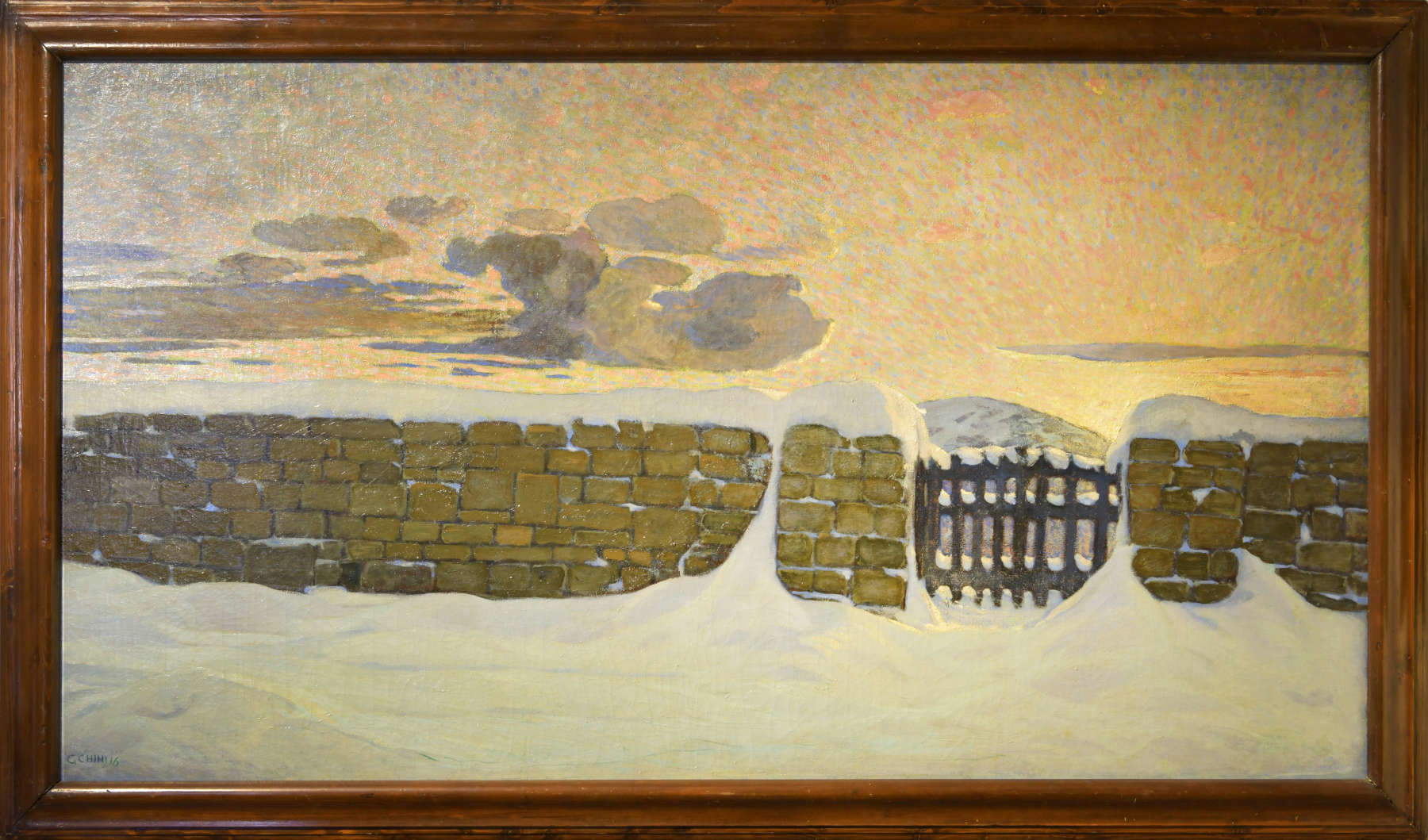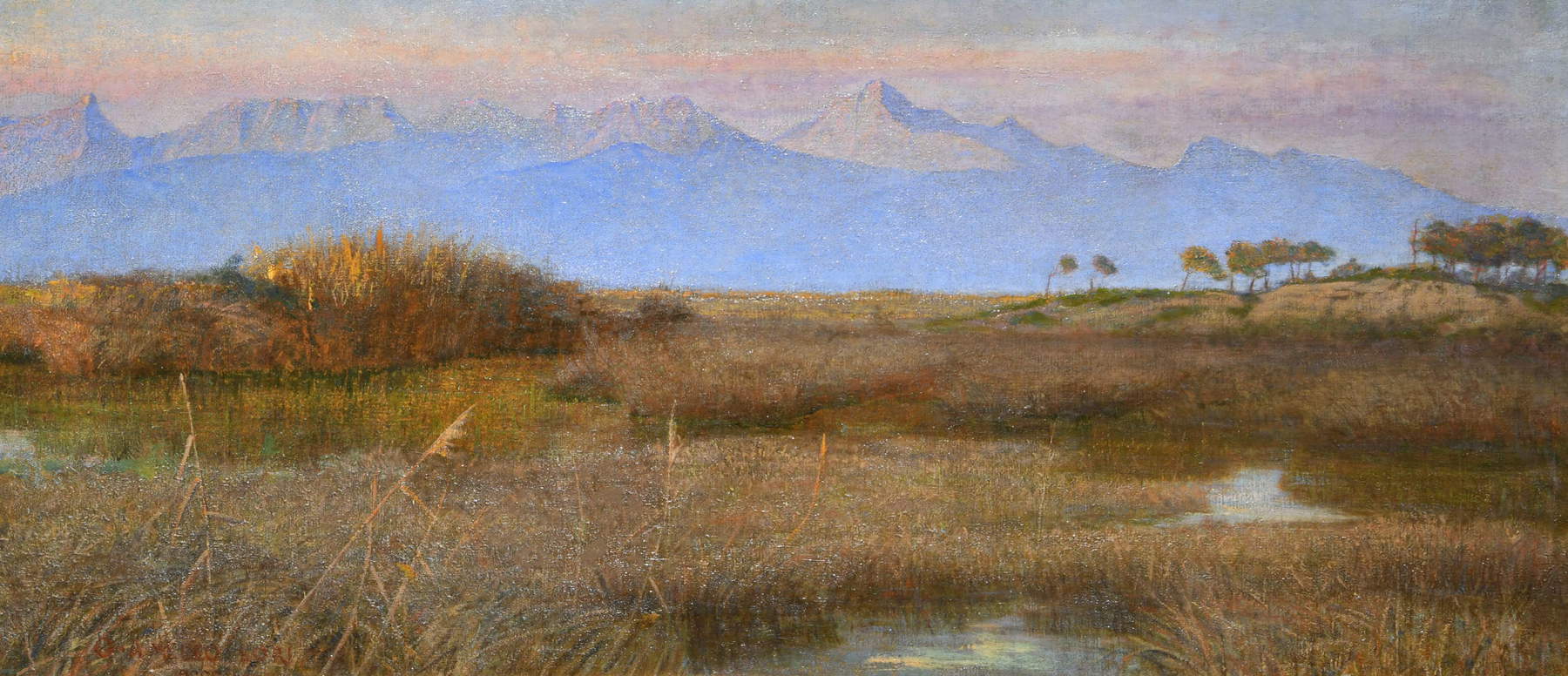Pisa, Palazzo Blu opens the Hall of the Twentieth Century with works by leading local artists
The Hall of the Twentieth Century, set up inside the historic mansion, was inaugurated yesterday, March 21, 2024, at the Palazzo Blu in Pisa. The hall represents an initiative to enhance and re-evaluate artists linked to and active in Pisa. The new arrangement presents to the public works already in the Pisa Foundation’s collections, collected and placed ex novo in the room, and also offers three new acquisitions, again by important artists of the twentieth century, plus a fourth work from the nineteenth century. The works making their entrance to Palazzo Blu and on display for the first time are ’Veduta. The Apuan Alps from the Marina di Pisa’ (1901) by Guglielmo Amedeo Lori, ’The Gate (The Vow of Those Who Had No Grave )’ (1916) by Galileo Chini and ’The Monkey’ by Spartaco Carlini. These are joined by a painting by Karl Marko, ’Caprona, figures on the Arno,’ a view of Caprona, a 19th-century work that will be displayed in the Game Room.
The room contains works by some of the most representative Pisan artists of the last century, starting with Amedeo Lori, who was one of the protagonists of Tuscan pointillism. Umberto Vittorini and Salvatore Pizzarello, on the other hand, were the most significant exponents of an orientation toward expressionist currents. Ferruccio Pizzanelli is an interpreter of the so-called return to Order and the study of firm 15th-century Tuscan forms. Spartaco Carlini is present with a work dense with dreamlike and surreal moods. Gino Bonfanti, on the other hand, investigated landscape themes. By Fortunato Bellonzi a canvas is exhibited that recalls his youthful pictorial activity, before being abandoned due to his choice to become secretary of the Quadriennale in Rome, which is of considerable interest because it recalls how an interesting nucleus of Futurist painters had been established in Pisa. Mino Rosi devoted himself to painting for a long time, and after World War II he did not disdain to measure himself against early 20th-century French painting, as in the canvas present in Palazzo Blu. As for Giuseppe Bartolini, he is still one of the greatest contemporary Pisan artists, whose research poised between hyperrealism and metaphysical suggestions stands as one of the cornerstones of figure painting in recent decades. Also of note is a vase from the Richard Ginori manufacture in Doccia, made under the artistic direction of Gio Ponti: an urn called “lancesca” in homage to the architect Emilio Lancia.
“The Pisa Foundation has chosen to collect and collect works that relate to the art and history of Pisa and its territory by author, theme or patron: a choice that aims to make known and enhance the cultural identity of the city, as it was formed and continues to develop in its long history,” explains Cosimo Bracci Torsi, president of Palazzo Blu “The collection has been enriched in recent years with works by Artemisia Gentileschi, Simon Vouet and Orazio Riminaldi that allow us to recall a lesser-known period of the city’s revival in the grand ducal state, made particularly interesting and significant by the presence of two families of great painters such as the Lomi Gentileschi and the Riminaldi. The interest of Palazzo Blu, however, does not turn only to a more or less distant past. Culture and art are in fact the products of society in its continuous evolution, and to the ”yesterday“ of the twentieth century we wanted to dedicate a room in the permanent exhibition, with some artists who worked in Pisa in the last century. Thanks to the latest important purchases by the Pisa Foundation, it has been possible to build an itinerary that presents the first decades of the century with the pointillism of Amedeo Guglielmo Lori, the Art Nouveau of Galileo Chini, an extraordinary and eclectic artist who left important frescoes and decorations in our city, and the dreamlike symbolism of Spartaco Carlini. The path then continues with Fortunato Bellonzi’s Littorio futurism and the return to a more traditional figurativeness of Pizzanelli, Pizzarello and Bonfanti, ending with the contemporaneity of Giuseppe Bartolini’s splendid canvas.”
“I think it is safe to say, with satisfaction, that Palazzo Blu is a museum in continuous transformation,” says Stefano Del Corso, president of the Pisa Foundation. “The ’goal that the Pisa Foundation intends to pursue, through the acquisition of new works of art that enrich the collections, is to renew the opportunity for visitors to return often to the museum rooms to appreciate what is new. On this occasion, we present the installation of the Twentieth Century Room, with three new works whose authors are Galileo Chini, Amedeo Lori and Spartaco Carlini. To which is added a 19th-century painting by Karl Marco. These are all artists who had a connection with Pisa and allow us to explore a lesser-known historical moment in the city’s artistic life. These recently acquired works are included in a thematic itinerary with others already known to the public at Palazzo Blu, and the three from the 1900s are brought together in a dedicated room.”
“The Hall of the Twentieth Century is an important opportunity to rediscover artists often unjustly forgotten by the general public, but also to be able to appreciate the latest acquisitions made by the Pisa Foundation,” stresses Stefano Renzoni, art historian and scientific adviser to Palazzo Blu “The large painting by Galileo Chini poetically evokes the fallen soldiers of World War I and is part of a diptych whose second example is kept in the offices of the Presidency of the Republic. The beautiful painting by the Pisan Amedeo Lori is the only one by the Divisionist painter to be exhibited in his hometown in a public place. As for Spartaco Carlini, the work ’The Monkey’ tells the full story of him as a painter inclined to a sometimes visionary language, an expressionistic figure dense with dreamlike and surreal moods.”




Notes on artists
Galileo Chini (Florence, 1873 - 1956) had significant ties with Pisa. In 1901 he painted in the church of S. Francesco, and in 1907 he collaborated with Ferruccio Pizzanelli at the Venice Biennale. In 1922, the Chini workshop in Borgo San Lorenzo created the stained glass windows in the Aula Magna of the Sapienza University. Starting in 1926 he decorated Palazzo Vincenti with historical episodes from Pisa. In 1941 he painted a ’View of the Piazza del Duomo’ of Pisa. Many of his works are on display in the Hall of the Twentieth Century, including a signed screen entitled Waves, Damesels of Numidia and Redfish, which recalls his interest in Eastern culture. The canvas The Vow of Those Who Had No Grave documents the influences of Divisionist painting on Chini. The room also features three elegant polychrome majolica vases produced by the Fornaci di San Lorenzo, founded in 1906.
Guglielmo Amedeo Lori (Pisa, 1869 - Viareggio, 1913) was a renowned Tuscan Divisionist painter. His works, including Views of the Apuan Alps from the Marina di Pisa, reflect his connection to the region. His untimely death prevented wider fame. His paintings are held in important institutions such as the National Gallery of Modern Art in Rome and Palazzo Pitti. The work acquired by the Pisa Foundation is significant because it is the only one on display in his hometown, while another of his masterpieces is part of the office furniture in Palazzo Gambacorti.
Spartaco Carlini (Pisa, 1884 - 1949), a painter from Pisa, is known for his expressionistic depiction of life and nature. The Monkey, acquired by the Pisa Foundation, embodies his distinctive artistic style, exploring the vitality and mystery of natural forms with a symbolist vision.
Karl Marko (Pest, 1822 - Moscow, 1891) was part of a family of painters active in Tuscany, based in Pisa in the 19th century. While his father Karl worked mainly in Pisa, Karl explored the surrounding countryside, showing interest in landscape and picturesque views. The Markos were associated with the Staggia School, forerunners of Macchiaiola painting. The Foundation painting offers a unique view of the Caprona fortress and the Arno River, highlighting his talent and closeness to contemporary Tuscan artists.
 |
| Pisa, Palazzo Blu opens the Hall of the Twentieth Century with works by leading local artists |
Warning: the translation into English of the original Italian article was created using automatic tools. We undertake to review all articles, but we do not guarantee the total absence of inaccuracies in the translation due to the program. You can find the original by clicking on the ITA button. If you find any mistake,please contact us.




























